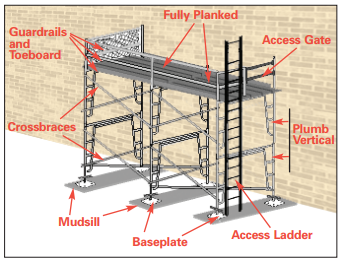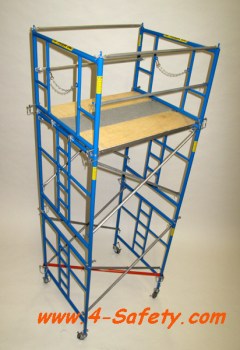Temporary Roof Scaffolding to Ensure Safe Working Conditions During Projects
Temporary Roof Scaffolding to Ensure Safe Working Conditions During Projects
Blog Article
The Benefits of Scaffolding for Security and Effectiveness in Structure Projects
Scaffolding is a necessary element in the world of building, considerably contributing to both safety and security and operational performance. The effect of scaffolding extends past fundamental security measures; its tactical execution can change project timelines and results (Scaffolding).
Enhanced Employee Safety

Boosted worker safety is a vital concern in the building market, where the threats associated with drops and crashes can have dire repercussions. Reliable scaffolding systems play an essential function in alleviating these threats by providing stable systems for employees at raised elevations. By ensuring that scaffolding is correctly set up and preserved, building companies can considerably minimize the probability of drops, which are amongst the leading sources of office injuries and casualties.
In addition, scaffolding boosts safety and security through its design features. Guardrails, toe boards, and non-slip surfaces add to a secure functioning setting, decreasing the threat of crashes. In addition, scaffolding permits employees to gain access to hard-to-reach areas without the need for makeshift services, which can compromise safety standards.
Training workers on the correct usage of scaffolding is similarly crucial. Making sure that workers are well-informed about lots capabilities, setting up treatments, and safety and security procedures further enhances the effectiveness of scaffolding in protecting against crashes. Finally, integrating robust scaffolding systems within construction tasks not just boosts employee security but additionally promotes a society of security that benefits the whole workforce while enhancing total productivity.
Improved Gain Access To and Movement

In addition, scaffolding enables the hassle-free transport of devices and products, lessening downtime connected with moving devices. Employees can successfully access numerous locations of a job, which is especially essential in complex builds where vertical and straight motion is constant - Scaffolding. This accessibility not only simplifies procedures however also enables groups to react rapidly to changing task needs
Furthermore, scaffolding can be tailored to suit details site conditions, boosting wheelchair in uneven or limited areas. This adaptability makes certain that building and construction activities can continue efficiently, regardless of the obstacles provided by the environment. By cultivating enhanced access and wheelchair, scaffolding plays a critical function in supporting building and construction crews and maximizing the general performance of building tasks.
Boosted Project Effectiveness
In construction, task efficiency is dramatically influenced by the reliable use scaffolding systems. By supplying a secure and steady system for workers, scaffolding lessens downtime and accelerates the speed of building and construction activities. With better access to raised job areas, groups can finish tasks extra rapidly, lowering the total task timeline.
The modular nature of modern-day scaffolding enables fast setting up and disassembly, enabling quick shifts in between different phases of a task. This Learn More Here flexibility not only improves workflow however additionally adds to better sychronisation amongst various trades, as multiple teams can work simultaneously on various sections of a structure.
Furthermore, scaffolding makes sure that workers are positioned appropriately to do their jobs without unnecessary stress or danger of injury, therefore reducing the likelihood of crashes that can cause costly delays. Improved security actions embedded in scaffolding systems, such as guardrails and toe boards, additional assistance effective procedures by preserving worker concentrate on the task available instead of security worries.

Adaptability for Various Jobs
Scaffolding systems attract attention for their adaptability across a variety of building tasks, with the ability of conference specific website needs and jobs. Their modular design permits quick modifications to fit different building kinds, from household to business structures, making certain that workers have safe gain access to at different elevations and angles.
These systems can be tailored for varied applications, such as façade job, interior remodellings, or sturdy commercial tasks. For example, light-weight aluminum scaffolds are click resources ideal for indoor work, while robust steel frameworks offer the needed support for massive construction. The flexibility of scaffolding encompasses its capacity to be configured for both long-term and momentary frameworks, permitting service providers to efficiently plan and execute their jobs.
Furthermore, scaffolding can be used in challenging settings, including metropolitan settings where space is minimal or on irregular terrain where standard access services are not practical. This adaptability lessens the need for numerous access solutions, minimizing prices and task timelines. By accommodating a range of jobs and problems, scaffolding improves the total efficiency and effectiveness of building and construction initiatives, confirming to be a vital property in the building market.
Conformity With Safety And Security Specifications
Just how can building and construction tasks make sure the safety and security of employees while maintaining efficiency? Regulatory structures, such as OSHA in the United States, provide standards that govern the use of scaffolding, ensuring that it meets strict security criteria.
Correct scaffolding style and installment play a critical function in compliance. Scaffolds should be created from high-grade materials and created to withstand the certain loads they will certainly encounter. Normal inspections and upkeep are vital to make certain that these frameworks remain secure throughout the job duration. Training workers on risk-free scaffold use and the significance of conformity with safety standards better strengthens a society of safety on-site.
In addition, documents and record-keeping pertaining to safety evaluations and worker training are important. These methods not only show compliance however also give accountability and transparency. Ultimately, by focusing on adherence to security requirements, building and construction tasks can foster a safer work setting, therefore boosting performance and performance without jeopardizing worker safety.
Conclusion
In verdict, scaffolding serves as a crucial component in building tasks, dramatically improving security and performance. Adherence to safety and security criteria highlights the importance of scaffolding in attaining successful task results, making it indispensable in the building link industry.
Scaffolding is a necessary part in the realm of construction, considerably adding to both security and operational performance. The impact of scaffolding prolongs beyond basic safety and security actions; its strategic execution can transform project timelines and outcomes. In conclusion, integrating robust scaffolding systems within building projects not only improves employee safety however also promotes a society of safety that profits the whole workforce while boosting total performance.
In conclusion, scaffolding serves as an essential component in building jobs, significantly enhancing safety and security and performance. Adherence to security standards emphasizes the significance of scaffolding in attaining effective project results, making it important in the building market.
Report this page